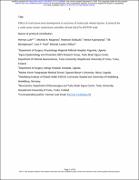| dc.description.abstract | Injury is a global health concern whose mortality disproportionately impact low-income countries. Compelling evidence from high-income countries show that rural trauma team
development courses (RTTDC) increase clinicians’ knowledge. There is a dearth of evidence from
controlled clinical trials to demonstrate the effect of RTTDC on process and patient outcomes. We
document a protocol for a multi-center cluster randomized controlled clinical trial which aims to
examine the impact of RTTDC on process and patient outcomes of motorcycle-related injuries.
This will be a two-armed parallel multiple period cluster randomized controlled clinical
trial in Uganda, where rural trauma team development training is not routinely conducted. We shall
recruit regional referral hospitals and include road traffic injured patients, interns, medical trainees,
and road traffic law enforcement professionals who serve as trauma care frontliners. Three hospitals
will be cluster randomized to RTTDC (intervention group) and the remaining three to standard care
(control group). The primary outcomes will be prehospital interval from accident scene to arrival at
emergency department, and referral-exit interval from the time the referral decision is made to
hospital exist in hours as a measure of process improvement. The secondary outcomes will be all
cause mortality, and morbidity of neurological, and orthopedic injuries based on the Glasgow
outcome scale and trauma outcome measure scores respectively at 90-days post injury. All
outcomes will be measured as final values. We shall compare baseline characteristics and outcomes
both at individual, and at cluster level as intervention versus control group. We shall use the mixed
effects regression models in Stata 15.0 to report any absolute or relative differences along with 95%
CIs. We shall perform subgroup analyses to control for confounding due to injury mechanisms and
severity. In parallel to the trial, we shall establish a motorcycle trauma outcome registry (MOTOR)
in consultation with community traffic police.
Our results could inform the design, implementation, and scalability of future rural
trauma teams and education programs. | en_US |


